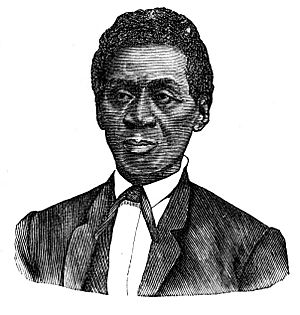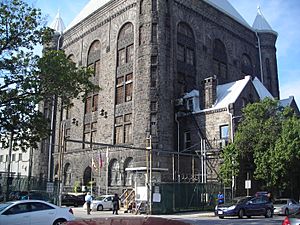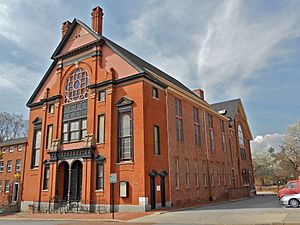Samuel Green (freedman) facts for kids
Samuel Green (born around 1802 – died February 28, 1877) was an enslaved person who later became a freedman and a minister. He was a brave leader on the Underground Railroad, a secret network that helped enslaved people escape to freedom. In 1857, he was arrested and found guilty of having a copy of the anti-slavery book Uncle Tom's Cabin by Harriet Beecher Stowe. This happened after an event known as the Dover Eight incident. He was sentenced to ten years in prison but was pardoned by the Governor of Maryland Augustus Bradford in 1862, after serving five years.
Samuel Green was an African American minister who helped start the Mt. Zion Methodist Church (now Faith United Methodist Church) in New East Market. After the American Civil War, he also helped create and worked at the Centenary Biblical Institute (now Morgan State University). This school trained men to become ministers. The Green family were members of the Orchard Street United Methodist Church in Baltimore.
Contents
Samuel Green's Early Life
Samuel Green was born around 1802 in East New Market, Maryland. We don't know much about his parents. His mother was enslaved, but his father's status is unknown. It's possible he was related to Harriet "Ritt" Green, who was the mother of the famous Harriet Tubman.
Life as an Enslaved Person
Green worked as an enslaved field hand in Dorchester County, Maryland. When his enslaver, Henry Nicholas, died in 1832, his will stated that Green should be freed after working for five more years.
Henry Nichols' will said: "It is my will and desire that my negro man Sam Green, be sold for a term of five years... and after the expiration of said terms I do hereby manumit and set them free."
Green became a blacksmith, which allowed him to earn and save money after his daily work. After just one year, Green was able to buy his freedom for the remaining four years of his service.
Marriage and Family Life
Green married Catherine (born around 1806), also known as "Kitty." They had two children: Samuel Jr., born in 1829, and Susan, born in 1832. His wife and children were enslaved by a man named Ezekial Richardson. In 1842, Green was able to buy his wife's freedom for $100. Green and Catherine stayed in the East New Market area.
In the 1830s, Green was given land near the Mt. Zion Methodist Church. He was part of a group of trustees who received this land. The Greens lived on Indian Creek, about six miles up the Choptank River. Green could read and write, and he likely taught his children these skills. He also had a strong belief in Methodism.
Green tried hard to buy his children's freedom, but he was not successful. Samuel Jr. and Susan were more valuable because they had many years of work ahead of them. They remained enslaved but lived with their parents until 1847. That year, Richardson sold the children to Dr. James Muse. In 1850, two other young children, Edward Johnson and a four-year-old girl, lived with the Greens.
In 1854, Samuel Jr. bravely escaped to Canada. Susan married and had two children. Sadly, she was separated from her family forever when Muse sold her to an enslaver in Missouri after Samuel Jr. ran away.
Free African Americans in Maryland
Maryland had the largest number of free African Americans in the United States. In 1860, more than half of all Black people in Dorchester County were free. Some enslaved people gained their freedom through their owners' wills. Others were allowed to work extra jobs and save enough money to buy their own freedom. However, laws were passed that limited the rights of free Black people. This was because people in power worried that free Black people would help enslaved people escape.
Samuel Green's Freedom and Activism
After Green became free, he worked as a farmer and as a minister in the African Methodist Episcopal Church in Dorchester County, Maryland. Rev. Samuel Green was a founder and trustee of the Mt. Zion Methodist Church, which is now Faith United Methodist Church. Green became well-respected by both Black and white communities in Dorchester County. In 1852, he was a delegate at a meeting in Baltimore for free Black people in Maryland. There, he spoke against ideas that encouraged Black people to move to Africa.
In 1855, he and his wife attended a national meeting of Black citizens in Philadelphia. Green was a delegate from Maryland. He met many important abolitionists (people who wanted to end slavery) from the North, including Mary Ann Shadd Cary, Frederick Douglass, and John Rock.
Working on the Underground Railroad
Green provided safe places for Harriet Tubman and other people who were escaping slavery. People suspected he was an Underground Railroad operator. However, he was so respected by the white community that he was able to help people for a while without being caught.
He helped organize Underground Railroad activities, including the escape of his own son, his son's friends, and the group known as the Dover Eight. In 1854, Samuel Jr. sent a letter urging his parents to come to Canada. He also asked them to help his friends run away. Peter Jackson followed Samuel Jr. to Canada in 1854. In late 1856, Joe Bailey and Peter Pennington ran away with Green's help. Green even traveled to Canada to visit his son and planned to move there with his wife.
Samuel Jr.'s Escape to Freedom
In August 1854, Samuel Jr., who was a skilled blacksmith, ran away from his enslaver, Muse. Harriet Tubman gave him encouragement and directions. He found his way to the Philadelphia office of William Still, a very important person in the Underground Railroad. Still wrote down the details of Green's escape. Still then sent him to Charles Hicks Bustill in Philadelphia, where Samuel Jr. stayed for four days. For his journey, he used the name Wesley Kinnard and received some money. Green traveled to New York City and then was guided to Canada, to a town called Salford in Ontario. Once settled, Samuel Jr. wrote to his parents, telling them he had successfully reached freedom and had "plenty of friends, plenty to eat, and to drink." After his escape, his sister Susan was sold to Missouri, separating her from her family.
Samuel Jr. married a woman named Louisa, and they had at least three children. In 1861, his wife and two children lived in Norwich, Ontario. Ten years later, he lived in Ancaster, Ontario. He died in 1875 at the age of 45.
The Dover Eight Incident
Green, who lived in East New Market, helped the Dover Eight group during their escape from Bucktown, Maryland. People suspected he was involved in this escape. After Green returned from visiting his son in Canada, Sheriff Robert Bell searched his house. Among other things, Bell found a letter from his son Samuel in Canada, a map of Canada, train schedules, and the book Uncle Tom's Cabin (1852) by Harriet Beecher Stowe. Green was arrested on April 4, 1857, for having Uncle Tom's Cabin. This book was seen as an "abolitionist handbill" because it spoke out against slavery. The book and other items were believed to "create discontent amongst the colored population." Green became a symbol of free Black people who helped others escape slavery.
Samuel Green's Trial and Imprisonment
Charles F. Goldsborough led the case against Green in a two-week trial in Dorchester County, Maryland. Since there was no direct proof that Green was involved in the Underground Railroad, Goldsborough argued that Uncle Tom's Cabin was meant to cause trouble. James Wallace, who owned enslaved people, was Green's defense lawyer. He strongly defended Green and argued against the claims about the anti-slavery materials. Green was found not guilty of having "abolition papers of an inflammatory character." However, he was found guilty of having "a certain abolition pamphlet called 'Uncle Tom's Cabin' ... calculated to create discontent amongst the colored population." This was based on a Maryland law from 1841. This law said that if any free Black person had any anti-slavery paper that could cause trouble among Black people, they would be guilty of a serious crime. The punishment could be ten to twenty years in prison. On May 14, 1857, Green was sentenced to at least ten years at the Maryland Penitentiary in Baltimore. It was very unusual for someone to be sent to prison just for owning an anti-slavery book.
Green was imprisoned in the Maryland State Penitentiary in Baltimore. Because he could read and write, he managed paperwork for the warden. The Green family sold their property to pay for the trial costs. His wife Catherine moved to Baltimore and earned money by doing laundry.
People asked the Governors of Maryland to pardon Green. White Methodists especially pushed for this, saying that many people, maybe even the governor, owned Uncle Tom's Cabin. After the Dover Eight escape, more enslaved people ran away, and enslavers wrote to the governors with their worries. Green said that after receiving a petition asking Governor Hicks to pardon him, the governor replied, "I know Green. So far his moral character goes, he is an honest man; but if I pardon him, I shall be called an abolitionist and mobbed." In March 1862, Governor Augustus Bradford pardoned Green. The condition was that Green had to leave the state within 60 days.
Samuel Green's Final Years
When he was freed, Samuel Green's story interested other abolitionists. He gave speeches along the East Coast of the United States. He worked with William Lloyd Garrison and William Still. He even received a copy of Uncle Tom's Cabin from Harriet Beecher Stowe herself. Green and his wife Eliza moved to London, Ontario in Canada.
After the American Civil War ended (1861–1865), Green worked as a domestic servant.
In 1870, Green returned to Dorchester County, where he lived with his wife Catherine and 9-year-old Frank Green. He was a member of the Delaware Conference of the Methodist Episcopal Church, where he focused on education. They settled in Baltimore in 1874. He helped start and worked at the Centenary Biblical Institute (now Morgan State University). This school trained men to become ministers. The Greens were members of the Orchard Street United Methodist Church in Baltimore.
Samuel Green died in Baltimore on February 28, 1877. He was buried at South Baltimore Cemetery, which is the historic Mount Auburn Cemetery, Baltimore's oldest African-American cemetery.
Samuel Green's Legacy
- In 2007, Faith United Methodist Church in East New Market received an award for an outstanding heritage project. During their Heritage Day in October 2007, a play was performed that showed Green helping to found the Mt. Zion Methodist Church (now Faith United Methodist Church) and serving as a trustee. The play also showed his imprisonment for having the Uncle Tom's Cabin book after the escape of the Dover Eight. The play was written by Barry O. Foreman, a local writer.
- There is also a historical marker at the Faith United Methodist Church that tells the story of Green's life.
- An exhibit at the Dorchester County Courthouse in Cambridge, Maryland explains how Green was tried and found guilty for owning Uncle Tom's Cabin.
- Nkeiru Okoye wrote an opera called Harriet Tubman: When I Crossed that Line to Freedom, which includes Samuel Green as a character. It was first performed in 2014.
See also
- List of slaves
- Harriet (2019 film)




